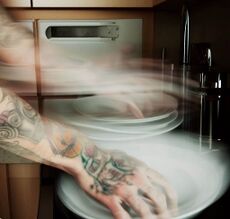Guide: Doing Chores
 | |
| Guide: Doing Chores | |
|---|---|
| Landmarks | Extended Witnessing Observe Your Judgment and Non-Judgment |
Guides are a Pathway in The Map of Everyday Enlightenment which are typically articles about a particular time and place for meditative practices. Guides contain Landmarks that highlight examples of how this could work for you, as well as other explanations of how to make use of certain concepts or techniques. The Landmarks in Guides can be reviewed in the context of progress through the Realms of Everyday Enlightenment, and when used in that way, Guides become another way to decide where to go next.
The Guide to Doing Chores is all about the chores that need to get done every day, often throughout each day. Due to the monotonous and even distasteful nature of doing chores, applying meditative practices during those tasks has two benefits. First, many of the practices in the Lenses are very helpful in making things less unpleasant, through reframing the way we perceive and experience those moments. Second, chores themselves open up special opportunities to practice examining our thoughts and emotions under minor stress.
Use the following Landmarks as ways to integrate meditative practices into your everyday life and to check in on how you are progressing in your own journey.
Landmark: Observe Your Judgment and Non-Judgment
 | |
| Landmark: Observe Your Judgment and Non-Judgment | |
|---|---|
| Beacons | Attention |
| Realms | Enrollment |
| Lenses | Non-Judgment |
| Guides | Doing Chores |
The Landmark of Observe Your Judgment and Non-Judgment is where you will learn about how to simply observe experience and thoughts. Observation is a necessary part of being Non-Judgmental, as it is a neutral way of experiencing things. Additionally, before we can learn more about the thoughts in our mind, we first must learn to Observe them. This Landmark is within the Realm of Enrollment, and is part of the Beacon of Attention, more specifically the Lens of Non-Judgment.
Landmark Lookouts:
- Observe Experience: Are you able to simply observe what is happening, including both what you see, and what you think about what you see?
- Observe Judgment: Can you observe the Judgmental thoughts passing through your mind without judging those thoughts themselves, just observing they are there?
- Observe Non-Judgment: Are you able to observe yourself Experiencing The Now and feel the difference between Judging what you see, and resting in Non-Judgment?
Observing Non-Judgment could be done in many places, but shopping is a great example because this is one place where we see a lot of different things that we commonly "judge" over and over. This is a Landmark of Enrollment so as you go through these steps, remember the goal is to practice simply Observing what is going on around you, and if you have any Judgmental thoughts, "Observe" those thoughts, and let them pass by. Everyone is different, but as you shop, you might have these types of Judgements:
- The parking lot is packed... there will probably be long lines inside.
- This shopping cart has a gross piece of trash in it.
- Why is everyone blocking the aisle?
- His shoes are so dirty.
- This costs way too much.
- Why did they put the apples near the coffee, that doesn't make any sense.
- This line is too long.
During your Shopping, you are going to try two things:
- Observe everything you see, and make sure you take in a variety of things. You want to "Experience the Now", and all the things that are happening.
- If you experience any Judgment about what is happening, try to notice that thought as it passes through your mind.
By doing those two things, you are strengthening your ability to practice Non-Judgment, by first being more present in the moment, and second, learning to replace the Judgment with something else. Here are some counter-examples of how you might Shop with Non-Judgment practicing those two things - observing The Now and observing your judgmental thoughts.
- I have arrived at the parking lot.
- I selected this shopping cart.
- I will come back to this aisle in a few minutes.
- That man is wearing shoes. I see they are dirty, and I see that I am using that to pass judgment on him.
- This item costs $2.99. I can see I am experiencing some sort of frustration because of that.
- There are apples here. There is coffee here.
- I am in a line. There are 4 people in front of me. That person is buying paper towels.
Landmark: Extended Witnessing
 | |
| Landmark: Extended Witnessing | |
|---|---|
| Beacons | Association |
| Realms | Engagement |
| Lenses | Witnessing |
| Guides | Doing Chores |
The Landmark of Extended Witnessing asks whether you are able to experience a form of Witnessing for longer periods of time. This Landmark is within the Realm of Engagement, and is part of the Beacon of Association, more specifically the Lens of Witnessing.
Landmark Lookouts:
- Understanding of Witnessing: Based on your practice, do you understand the goals and experience of Witnessing?
- Experience Witnessing Readily: Can you slip into the mode of Witnessing whenever you intend to?
- Prolonged Witnessing: When in a state of Witnessing can you maintain it (or at least shift back to it repeatedly) for more than a few minutes?
This is an example of a fairly complex task, but it involves repeating certain steps over and over, which is a chance to practice without judgement. If you find that you weren't able to stay mindful while taking one plate out, maybe you can for the next plate! Also, be sure to adapt these steps to how you personally like to empty the dishwasher, this might not be the way you do it.
- Open the dishwasher and look at the dishes
- Become as mindful as you know how
- Without trying to choose, allow yourself to pick up one dish
- Appreciate that you had no judgement or decision in which dish was picked up
- Appreciate the number of complicated micromovements necessary to pick up a dish
- Again, without any decision making, notice yourself walking to the cupboard
- Appreciate that walking also takes no conscious decisions, even though there are many parts that come together to make walking possible
- Continue on in this fashion until you find yourself back at the dishwasher, and appreciate the mindful nature of what you're doing
- Keep practicing being more and more mindful each time you put away a dish, you shouldn't need any thoughts or impulses whatsoever
- Once you are done take a moment to review the steps and concepts of Witnessing to appreciate what just happened
